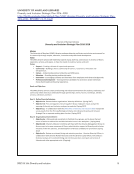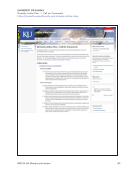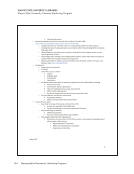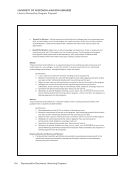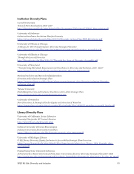49 SPEC Kit 356: Diversity and Inclusion
We created an inclusion director position that is a direct report to the university librarian, joined the
ACRL Diversity Alliance, started a high school internship program targeting populations historically
underrepresented in the profession, and are beginning a partnership with the only HBCU with a
library science school.
We don’t have a library diversity/inclusion program. The library relies on Human Resources to provide
programs on diversity/inclusion.
We had a program that offered a single library school student tuition support and financial support
during school and then a paid residency program after. This program was not continued because it had
little impact for the cost.
We have added diversity and inclusion as core values, and a member of our team has been through
intensive training on the topic. Our Associate Dean of Administrative Services is a member of the
Diversity Counsel, and we have focused more on bringing staff training programs to the employees
regarding diversity and inclusion.
We have become more proactive in recruiting new faculty from a diverse pool. We have increased the
number of places we advertise. We have also increased activities and relationships with groups on
campus through outreach initiatives by librarians.
We have become more systematic, more formal and also more informal, more concerned with
achieving positive, specific outcomes. Changes in the world of librarianship, especially from print to
electronic and ownership to access, demand that we be more cognizant of our faculty and staff, their
skills and their roles, and their opportunities for success.
We have broadened the scope of our diversity statement to include staff, services, and collections.
We have changed the focus of our showcase series, to offer more informal presentations than in the
past, inviting community leaders to participate in “kitchen table” conversations about issues related to
social justice, race, ethnicity, disabilities, etc.
We have created a Library Diversity and Inclusion Committee that has been charged with many
library initiatives.
We have expanded our efforts to insure our initiatives include more than just race/ethnicity. As a result,
we have had more training opportunities in the areas of age, gender, sexual orientation, language,
religion, disability and/or health status, gender identity/expression, veteran status, geographic origins,
and socio-economic status.
We have made a concerted effort to directly identify diversity in all our programs—calling it out as a
specific component in all our programs and services.
We have not had a plan or focused initiatives in the past. We now have a robust, comprehensive,
measurable plan in place, so the change is significant.
We have provided implicit bias awareness training to all staff with longer workshops for supervisors.
We are examining our employee viewpoint survey from a variety of demographic angles.
We have representation on the campus Academic Council for Diversity &Inclusion. This group is
developing a theory of change for recruiting and retaining a diverse study body as well as a diverse body
of faculty and staff.
We haven’t had any specific plans in the past, though this may change given the creation of our recent
Diversity and Inclusion Team, as well as an increasing notice on campus of issues related to diversity
and inclusion. We have also recently posted a position for an Inclusion and Accessibility Librarian.
A note that our Resident Librarian Program, while created more than five years ago, was partly in
response to campus-wide efforts to diversify staff. However, due to budget constraints the program has
We created an inclusion director position that is a direct report to the university librarian, joined the
ACRL Diversity Alliance, started a high school internship program targeting populations historically
underrepresented in the profession, and are beginning a partnership with the only HBCU with a
library science school.
We don’t have a library diversity/inclusion program. The library relies on Human Resources to provide
programs on diversity/inclusion.
We had a program that offered a single library school student tuition support and financial support
during school and then a paid residency program after. This program was not continued because it had
little impact for the cost.
We have added diversity and inclusion as core values, and a member of our team has been through
intensive training on the topic. Our Associate Dean of Administrative Services is a member of the
Diversity Counsel, and we have focused more on bringing staff training programs to the employees
regarding diversity and inclusion.
We have become more proactive in recruiting new faculty from a diverse pool. We have increased the
number of places we advertise. We have also increased activities and relationships with groups on
campus through outreach initiatives by librarians.
We have become more systematic, more formal and also more informal, more concerned with
achieving positive, specific outcomes. Changes in the world of librarianship, especially from print to
electronic and ownership to access, demand that we be more cognizant of our faculty and staff, their
skills and their roles, and their opportunities for success.
We have broadened the scope of our diversity statement to include staff, services, and collections.
We have changed the focus of our showcase series, to offer more informal presentations than in the
past, inviting community leaders to participate in “kitchen table” conversations about issues related to
social justice, race, ethnicity, disabilities, etc.
We have created a Library Diversity and Inclusion Committee that has been charged with many
library initiatives.
We have expanded our efforts to insure our initiatives include more than just race/ethnicity. As a result,
we have had more training opportunities in the areas of age, gender, sexual orientation, language,
religion, disability and/or health status, gender identity/expression, veteran status, geographic origins,
and socio-economic status.
We have made a concerted effort to directly identify diversity in all our programs—calling it out as a
specific component in all our programs and services.
We have not had a plan or focused initiatives in the past. We now have a robust, comprehensive,
measurable plan in place, so the change is significant.
We have provided implicit bias awareness training to all staff with longer workshops for supervisors.
We are examining our employee viewpoint survey from a variety of demographic angles.
We have representation on the campus Academic Council for Diversity &Inclusion. This group is
developing a theory of change for recruiting and retaining a diverse study body as well as a diverse body
of faculty and staff.
We haven’t had any specific plans in the past, though this may change given the creation of our recent
Diversity and Inclusion Team, as well as an increasing notice on campus of issues related to diversity
and inclusion. We have also recently posted a position for an Inclusion and Accessibility Librarian.
A note that our Resident Librarian Program, while created more than five years ago, was partly in
response to campus-wide efforts to diversify staff. However, due to budget constraints the program has


















































































